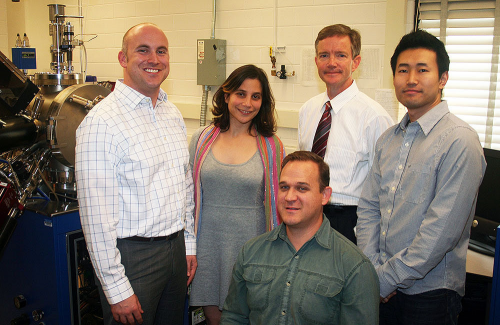Refined materials provide booster shot for solar energy conversion

If you want to get the most out of the sun, you have to improve the performance of the materials used.
An interdisciplinary team of Engineering at Illinois researchers has set its sights on improving the materials that make solar energy conversion/photocatalysis possible. Together, they have developed a new form of high-performance solar photocatalyst based on the combination of the TiO2 (titanium dioxide) and other "metallic" oxides that greatly enhance the visible light absorption and promote more efficient utilization of the solar spectrum for energy applications.
"This is a fundamentally new way of approaching these matters," explained Lane Martin, who is an assistant professor in the Department of Materials Science and Engineering at Illinois. "Our research group incorporatesaspects of condensed matter physics, semiconductor device engineering, and photochemistry to make new performance possible. From these materials we can imagine carbon-neutral energy production of clean-burning fuels, waste water purification and remediation, and much more.
"As a follow-up to our prior work, we expanded our discovery of new strongly absorbing energy materials," Martin added. "The overall concept is that we have developed a new form of high-performance solar photocatalyst based on the combination of the TiO2 and 'metallic' oxides." The group's paper "Enhanced photoelectrochemical activity in all-oxide heterojunction devices based on correlated 'metallic' oxides," appears in the journal, Advanced Materials (Volume 25, Issue 43, pages 6201–6206). The researchers also have a patent application pending for this work.
According to Martin the research paper addresses the most pressing limiting factor of these materials for applications – their poor absorption of light.
"This paper covers several new variations where we integrate chemically compatible correlated 'metallic' oxides with the model n-type, wide band gap oxide semiconductor TiO2 to produce high-performance photocatalytic heterojunctions. These composite structures operate on the principle of hot carrier injection from the 'metallic' oxide into the TiO2. "
These effects are made possible by harnessing the diverse range of correlated electron physics of common metallic oxide materials including n-type LaNiO3 (lanthanum nickelate), SrRuO3 (strontium ruthenate), and SrVO3 (strontium vanadate) and p-type La0.5Sr0.5CoO3 (lanthanum strontium cobaltite) and La0.7Sr0.3MnO3 (lanthanum strontium manganite). These materials have been extensively explored (individually) for their novel electronic transport, magnetic properties, and other exotic physical phenomena and are widely utilized as epitaxial bottom electrodes in ferroic heterostructures.
Martin noted that one of the new materials studied (La 0.5Sr0.5CoO3-based devices) demonstrated photocatalytic activities that are 27-, 6.2-, and 3-times larger than that for a single-layer TiO2 film, nanopowder Degussa P25 samples, and the prior report of devices based on SrRuO3, respectively.
More information: onlinelibrary.wiley.com/doi/10 … a.201303144/abstract
Journal information: Advanced Materials
Provided by University of Illinois at Urbana-Champaign

















